WealthWise's Balanced Scorecard and Sustainability Reporting Analysis
VerifiedAdded on 2022/10/02
|8
|2773
|249
Report
AI Summary
This report provides a comprehensive analysis of WealthWise's approach to balanced scorecards and sustainability reporting. It begins by defining sustainability reporting and explaining its relevance for WealthWise, a public insurance entity focused on social responsibility. The report then identifies and evaluates key performance indicators (KPIs) used by WealthWise, encompassing economic, social, and environmental aspects, and explains how these indicators can be applied to achieve the company's mission of supporting employees and promoting a better world. Furthermore, the report suggests alternative performance measures to enhance WealthWise's performance measurement system, including employee satisfaction and diversity metrics. The report also outlines steps a CEO can take to encourage employees to behave in a manner that supports sustainability, emphasizing the importance of defining purpose, creating a sustainable culture, and fostering employee engagement. This assignment, created by a student, offers valuable insights into strategic performance measurement and sustainability reporting.
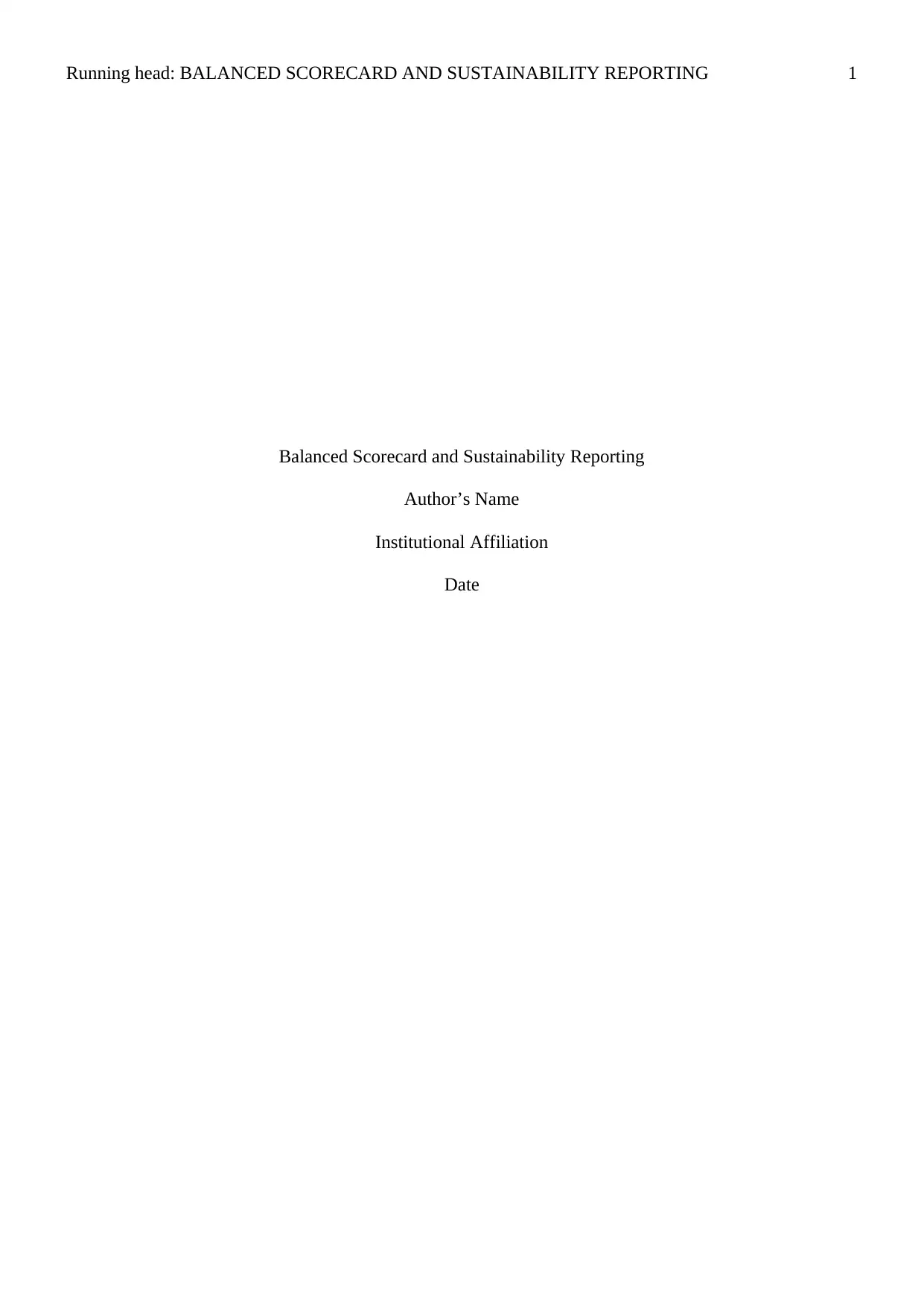
Running head: BALANCED SCORECARD AND SUSTAINABILITY REPORTING 1
Balanced Scorecard and Sustainability Reporting
Author’s Name
Institutional Affiliation
Date
Balanced Scorecard and Sustainability Reporting
Author’s Name
Institutional Affiliation
Date
Paraphrase This Document
Need a fresh take? Get an instant paraphrase of this document with our AI Paraphraser
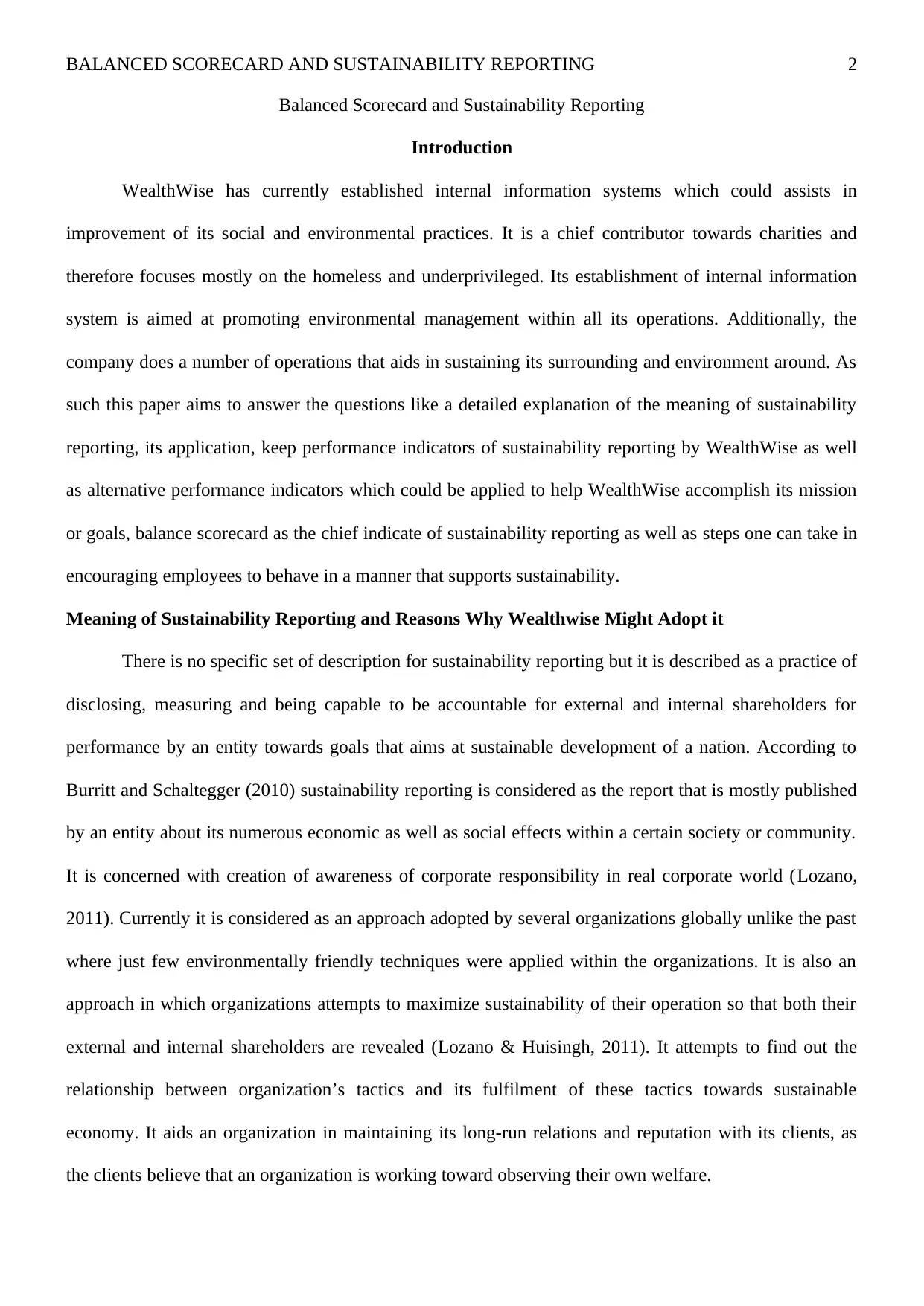
BALANCED SCORECARD AND SUSTAINABILITY REPORTING 2
Balanced Scorecard and Sustainability Reporting
Introduction
WealthWise has currently established internal information systems which could assists in
improvement of its social and environmental practices. It is a chief contributor towards charities and
therefore focuses mostly on the homeless and underprivileged. Its establishment of internal information
system is aimed at promoting environmental management within all its operations. Additionally, the
company does a number of operations that aids in sustaining its surrounding and environment around. As
such this paper aims to answer the questions like a detailed explanation of the meaning of sustainability
reporting, its application, keep performance indicators of sustainability reporting by WealthWise as well
as alternative performance indicators which could be applied to help WealthWise accomplish its mission
or goals, balance scorecard as the chief indicate of sustainability reporting as well as steps one can take in
encouraging employees to behave in a manner that supports sustainability.
Meaning of Sustainability Reporting and Reasons Why Wealthwise Might Adopt it
There is no specific set of description for sustainability reporting but it is described as a practice of
disclosing, measuring and being capable to be accountable for external and internal shareholders for
performance by an entity towards goals that aims at sustainable development of a nation. According to
Burritt and Schaltegger (2010) sustainability reporting is considered as the report that is mostly published
by an entity about its numerous economic as well as social effects within a certain society or community.
It is concerned with creation of awareness of corporate responsibility in real corporate world (Lozano,
2011). Currently it is considered as an approach adopted by several organizations globally unlike the past
where just few environmentally friendly techniques were applied within the organizations. It is also an
approach in which organizations attempts to maximize sustainability of their operation so that both their
external and internal shareholders are revealed (Lozano & Huisingh, 2011). It attempts to find out the
relationship between organization’s tactics and its fulfilment of these tactics towards sustainable
economy. It aids an organization in maintaining its long-run relations and reputation with its clients, as
the clients believe that an organization is working toward observing their own welfare.
Balanced Scorecard and Sustainability Reporting
Introduction
WealthWise has currently established internal information systems which could assists in
improvement of its social and environmental practices. It is a chief contributor towards charities and
therefore focuses mostly on the homeless and underprivileged. Its establishment of internal information
system is aimed at promoting environmental management within all its operations. Additionally, the
company does a number of operations that aids in sustaining its surrounding and environment around. As
such this paper aims to answer the questions like a detailed explanation of the meaning of sustainability
reporting, its application, keep performance indicators of sustainability reporting by WealthWise as well
as alternative performance indicators which could be applied to help WealthWise accomplish its mission
or goals, balance scorecard as the chief indicate of sustainability reporting as well as steps one can take in
encouraging employees to behave in a manner that supports sustainability.
Meaning of Sustainability Reporting and Reasons Why Wealthwise Might Adopt it
There is no specific set of description for sustainability reporting but it is described as a practice of
disclosing, measuring and being capable to be accountable for external and internal shareholders for
performance by an entity towards goals that aims at sustainable development of a nation. According to
Burritt and Schaltegger (2010) sustainability reporting is considered as the report that is mostly published
by an entity about its numerous economic as well as social effects within a certain society or community.
It is concerned with creation of awareness of corporate responsibility in real corporate world (Lozano,
2011). Currently it is considered as an approach adopted by several organizations globally unlike the past
where just few environmentally friendly techniques were applied within the organizations. It is also an
approach in which organizations attempts to maximize sustainability of their operation so that both their
external and internal shareholders are revealed (Lozano & Huisingh, 2011). It attempts to find out the
relationship between organization’s tactics and its fulfilment of these tactics towards sustainable
economy. It aids an organization in maintaining its long-run relations and reputation with its clients, as
the clients believe that an organization is working toward observing their own welfare.
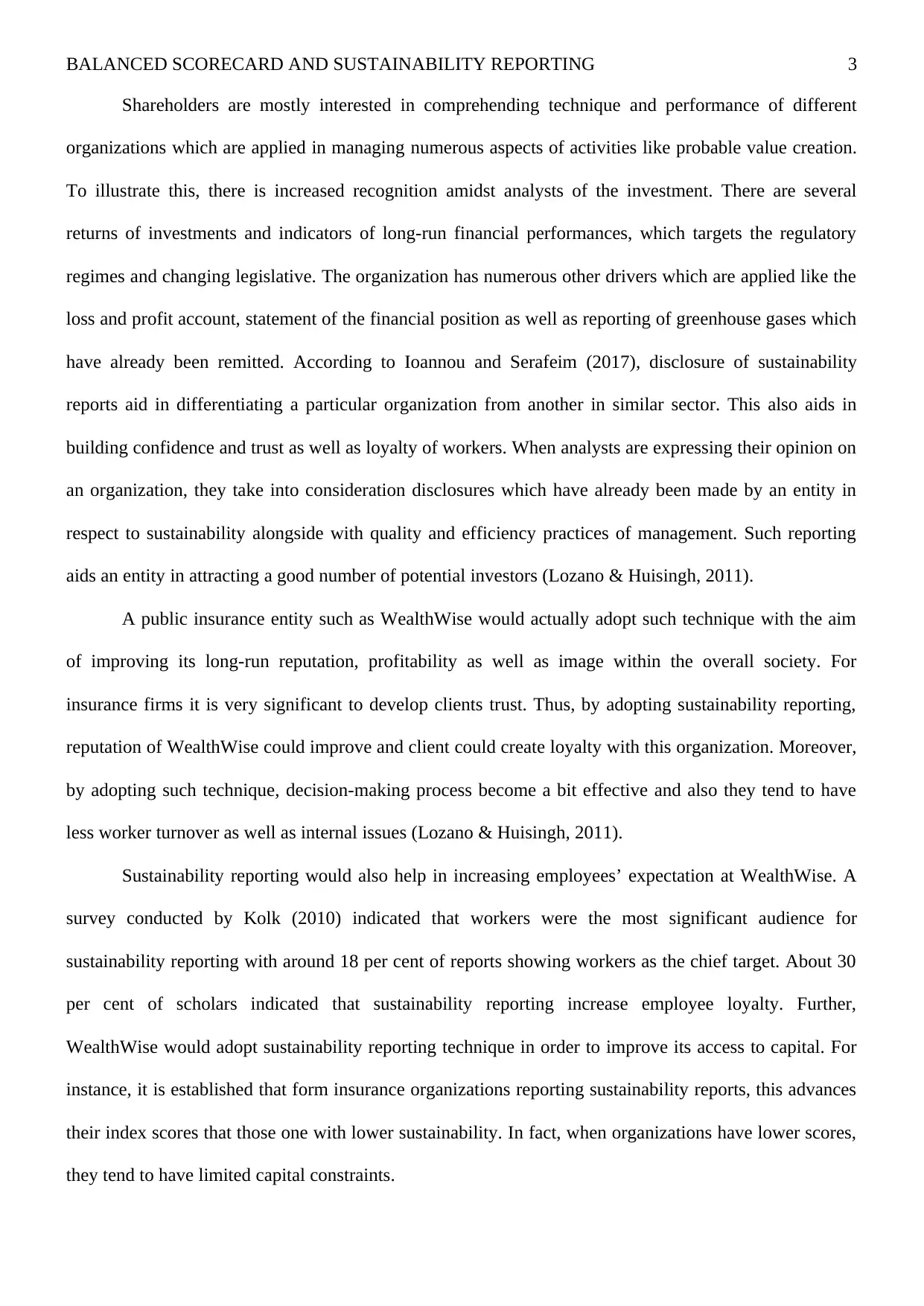
BALANCED SCORECARD AND SUSTAINABILITY REPORTING 3
Shareholders are mostly interested in comprehending technique and performance of different
organizations which are applied in managing numerous aspects of activities like probable value creation.
To illustrate this, there is increased recognition amidst analysts of the investment. There are several
returns of investments and indicators of long-run financial performances, which targets the regulatory
regimes and changing legislative. The organization has numerous other drivers which are applied like the
loss and profit account, statement of the financial position as well as reporting of greenhouse gases which
have already been remitted. According to Ioannou and Serafeim (2017), disclosure of sustainability
reports aid in differentiating a particular organization from another in similar sector. This also aids in
building confidence and trust as well as loyalty of workers. When analysts are expressing their opinion on
an organization, they take into consideration disclosures which have already been made by an entity in
respect to sustainability alongside with quality and efficiency practices of management. Such reporting
aids an entity in attracting a good number of potential investors (Lozano & Huisingh, 2011).
A public insurance entity such as WealthWise would actually adopt such technique with the aim
of improving its long-run reputation, profitability as well as image within the overall society. For
insurance firms it is very significant to develop clients trust. Thus, by adopting sustainability reporting,
reputation of WealthWise could improve and client could create loyalty with this organization. Moreover,
by adopting such technique, decision-making process become a bit effective and also they tend to have
less worker turnover as well as internal issues (Lozano & Huisingh, 2011).
Sustainability reporting would also help in increasing employees’ expectation at WealthWise. A
survey conducted by Kolk (2010) indicated that workers were the most significant audience for
sustainability reporting with around 18 per cent of reports showing workers as the chief target. About 30
per cent of scholars indicated that sustainability reporting increase employee loyalty. Further,
WealthWise would adopt sustainability reporting technique in order to improve its access to capital. For
instance, it is established that form insurance organizations reporting sustainability reports, this advances
their index scores that those one with lower sustainability. In fact, when organizations have lower scores,
they tend to have limited capital constraints.
Shareholders are mostly interested in comprehending technique and performance of different
organizations which are applied in managing numerous aspects of activities like probable value creation.
To illustrate this, there is increased recognition amidst analysts of the investment. There are several
returns of investments and indicators of long-run financial performances, which targets the regulatory
regimes and changing legislative. The organization has numerous other drivers which are applied like the
loss and profit account, statement of the financial position as well as reporting of greenhouse gases which
have already been remitted. According to Ioannou and Serafeim (2017), disclosure of sustainability
reports aid in differentiating a particular organization from another in similar sector. This also aids in
building confidence and trust as well as loyalty of workers. When analysts are expressing their opinion on
an organization, they take into consideration disclosures which have already been made by an entity in
respect to sustainability alongside with quality and efficiency practices of management. Such reporting
aids an entity in attracting a good number of potential investors (Lozano & Huisingh, 2011).
A public insurance entity such as WealthWise would actually adopt such technique with the aim
of improving its long-run reputation, profitability as well as image within the overall society. For
insurance firms it is very significant to develop clients trust. Thus, by adopting sustainability reporting,
reputation of WealthWise could improve and client could create loyalty with this organization. Moreover,
by adopting such technique, decision-making process become a bit effective and also they tend to have
less worker turnover as well as internal issues (Lozano & Huisingh, 2011).
Sustainability reporting would also help in increasing employees’ expectation at WealthWise. A
survey conducted by Kolk (2010) indicated that workers were the most significant audience for
sustainability reporting with around 18 per cent of reports showing workers as the chief target. About 30
per cent of scholars indicated that sustainability reporting increase employee loyalty. Further,
WealthWise would adopt sustainability reporting technique in order to improve its access to capital. For
instance, it is established that form insurance organizations reporting sustainability reports, this advances
their index scores that those one with lower sustainability. In fact, when organizations have lower scores,
they tend to have limited capital constraints.
⊘ This is a preview!⊘
Do you want full access?
Subscribe today to unlock all pages.

Trusted by 1+ million students worldwide
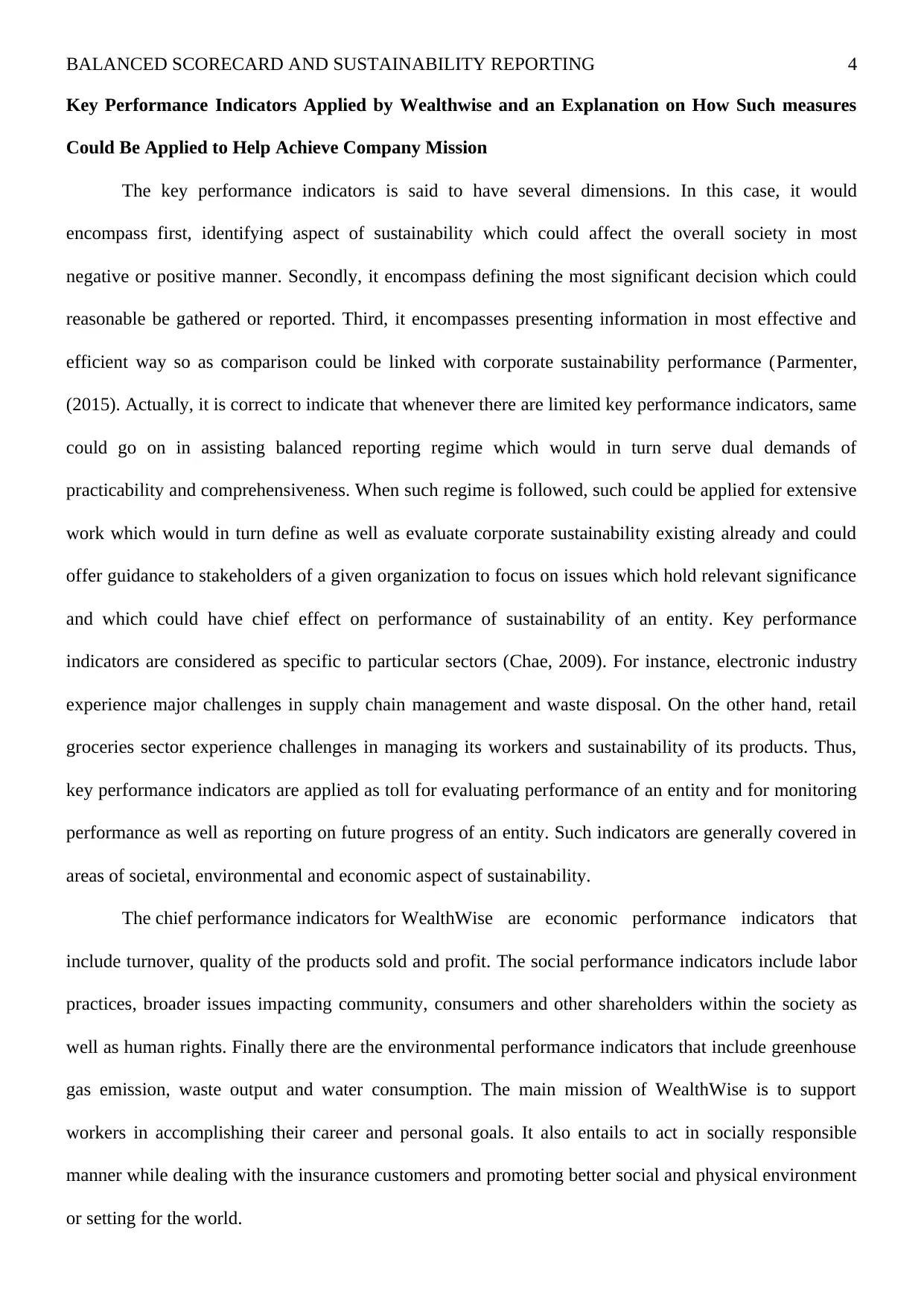
BALANCED SCORECARD AND SUSTAINABILITY REPORTING 4
Key Performance Indicators Applied by Wealthwise and an Explanation on How Such measures
Could Be Applied to Help Achieve Company Mission
The key performance indicators is said to have several dimensions. In this case, it would
encompass first, identifying aspect of sustainability which could affect the overall society in most
negative or positive manner. Secondly, it encompass defining the most significant decision which could
reasonable be gathered or reported. Third, it encompasses presenting information in most effective and
efficient way so as comparison could be linked with corporate sustainability performance (Parmenter,
(2015). Actually, it is correct to indicate that whenever there are limited key performance indicators, same
could go on in assisting balanced reporting regime which would in turn serve dual demands of
practicability and comprehensiveness. When such regime is followed, such could be applied for extensive
work which would in turn define as well as evaluate corporate sustainability existing already and could
offer guidance to stakeholders of a given organization to focus on issues which hold relevant significance
and which could have chief effect on performance of sustainability of an entity. Key performance
indicators are considered as specific to particular sectors (Chae, 2009). For instance, electronic industry
experience major challenges in supply chain management and waste disposal. On the other hand, retail
groceries sector experience challenges in managing its workers and sustainability of its products. Thus,
key performance indicators are applied as toll for evaluating performance of an entity and for monitoring
performance as well as reporting on future progress of an entity. Such indicators are generally covered in
areas of societal, environmental and economic aspect of sustainability.
The chief performance indicators for WealthWise are economic performance indicators that
include turnover, quality of the products sold and profit. The social performance indicators include labor
practices, broader issues impacting community, consumers and other shareholders within the society as
well as human rights. Finally there are the environmental performance indicators that include greenhouse
gas emission, waste output and water consumption. The main mission of WealthWise is to support
workers in accomplishing their career and personal goals. It also entails to act in socially responsible
manner while dealing with the insurance customers and promoting better social and physical environment
or setting for the world.
Key Performance Indicators Applied by Wealthwise and an Explanation on How Such measures
Could Be Applied to Help Achieve Company Mission
The key performance indicators is said to have several dimensions. In this case, it would
encompass first, identifying aspect of sustainability which could affect the overall society in most
negative or positive manner. Secondly, it encompass defining the most significant decision which could
reasonable be gathered or reported. Third, it encompasses presenting information in most effective and
efficient way so as comparison could be linked with corporate sustainability performance (Parmenter,
(2015). Actually, it is correct to indicate that whenever there are limited key performance indicators, same
could go on in assisting balanced reporting regime which would in turn serve dual demands of
practicability and comprehensiveness. When such regime is followed, such could be applied for extensive
work which would in turn define as well as evaluate corporate sustainability existing already and could
offer guidance to stakeholders of a given organization to focus on issues which hold relevant significance
and which could have chief effect on performance of sustainability of an entity. Key performance
indicators are considered as specific to particular sectors (Chae, 2009). For instance, electronic industry
experience major challenges in supply chain management and waste disposal. On the other hand, retail
groceries sector experience challenges in managing its workers and sustainability of its products. Thus,
key performance indicators are applied as toll for evaluating performance of an entity and for monitoring
performance as well as reporting on future progress of an entity. Such indicators are generally covered in
areas of societal, environmental and economic aspect of sustainability.
The chief performance indicators for WealthWise are economic performance indicators that
include turnover, quality of the products sold and profit. The social performance indicators include labor
practices, broader issues impacting community, consumers and other shareholders within the society as
well as human rights. Finally there are the environmental performance indicators that include greenhouse
gas emission, waste output and water consumption. The main mission of WealthWise is to support
workers in accomplishing their career and personal goals. It also entails to act in socially responsible
manner while dealing with the insurance customers and promoting better social and physical environment
or setting for the world.
Paraphrase This Document
Need a fresh take? Get an instant paraphrase of this document with our AI Paraphraser
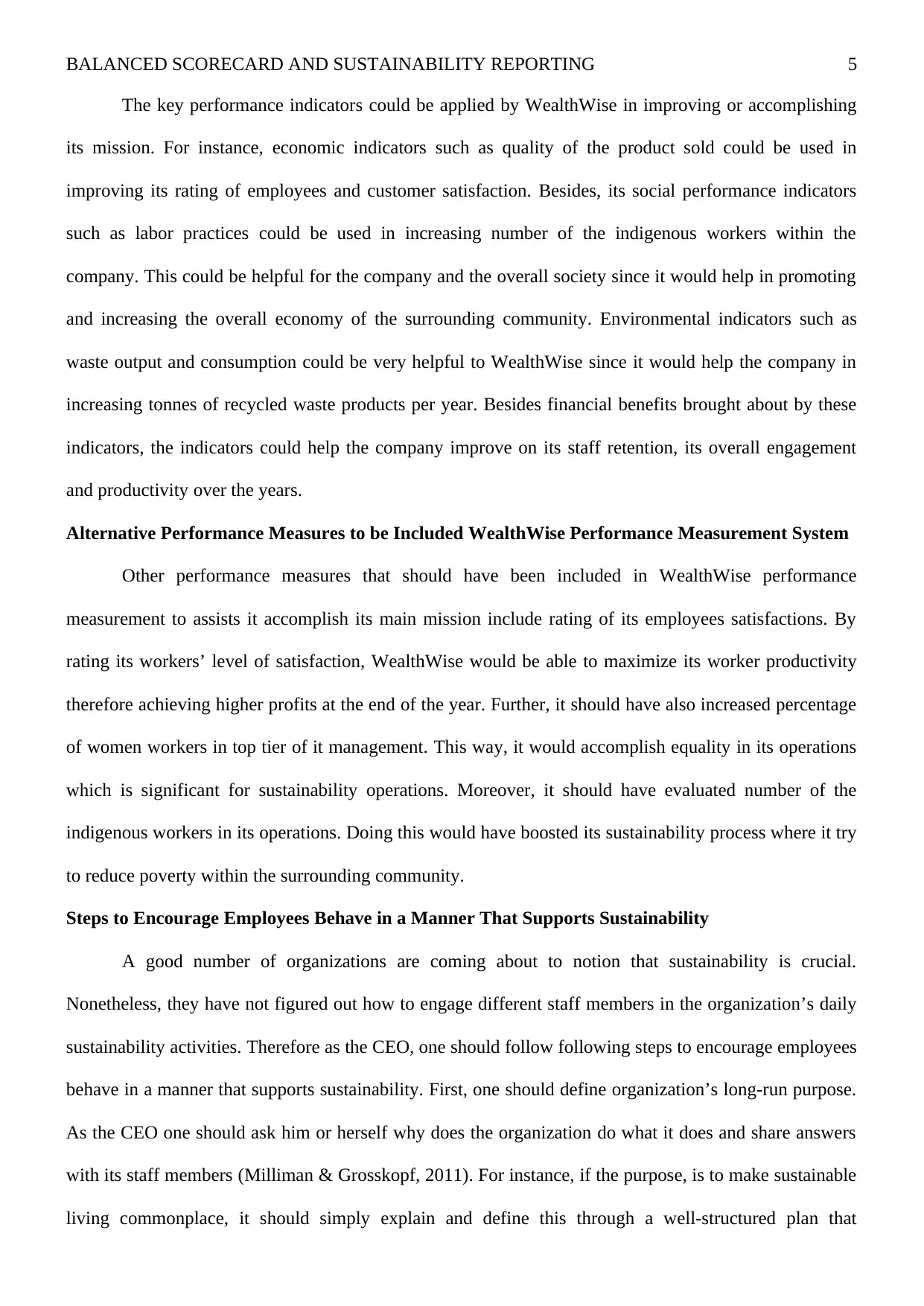
BALANCED SCORECARD AND SUSTAINABILITY REPORTING 5
The key performance indicators could be applied by WealthWise in improving or accomplishing
its mission. For instance, economic indicators such as quality of the product sold could be used in
improving its rating of employees and customer satisfaction. Besides, its social performance indicators
such as labor practices could be used in increasing number of the indigenous workers within the
company. This could be helpful for the company and the overall society since it would help in promoting
and increasing the overall economy of the surrounding community. Environmental indicators such as
waste output and consumption could be very helpful to WealthWise since it would help the company in
increasing tonnes of recycled waste products per year. Besides financial benefits brought about by these
indicators, the indicators could help the company improve on its staff retention, its overall engagement
and productivity over the years.
Alternative Performance Measures to be Included WealthWise Performance Measurement System
Other performance measures that should have been included in WealthWise performance
measurement to assists it accomplish its main mission include rating of its employees satisfactions. By
rating its workers’ level of satisfaction, WealthWise would be able to maximize its worker productivity
therefore achieving higher profits at the end of the year. Further, it should have also increased percentage
of women workers in top tier of it management. This way, it would accomplish equality in its operations
which is significant for sustainability operations. Moreover, it should have evaluated number of the
indigenous workers in its operations. Doing this would have boosted its sustainability process where it try
to reduce poverty within the surrounding community.
Steps to Encourage Employees Behave in a Manner That Supports Sustainability
A good number of organizations are coming about to notion that sustainability is crucial.
Nonetheless, they have not figured out how to engage different staff members in the organization’s daily
sustainability activities. Therefore as the CEO, one should follow following steps to encourage employees
behave in a manner that supports sustainability. First, one should define organization’s long-run purpose.
As the CEO one should ask him or herself why does the organization do what it does and share answers
with its staff members (Milliman & Grosskopf, 2011). For instance, if the purpose, is to make sustainable
living commonplace, it should simply explain and define this through a well-structured plan that
The key performance indicators could be applied by WealthWise in improving or accomplishing
its mission. For instance, economic indicators such as quality of the product sold could be used in
improving its rating of employees and customer satisfaction. Besides, its social performance indicators
such as labor practices could be used in increasing number of the indigenous workers within the
company. This could be helpful for the company and the overall society since it would help in promoting
and increasing the overall economy of the surrounding community. Environmental indicators such as
waste output and consumption could be very helpful to WealthWise since it would help the company in
increasing tonnes of recycled waste products per year. Besides financial benefits brought about by these
indicators, the indicators could help the company improve on its staff retention, its overall engagement
and productivity over the years.
Alternative Performance Measures to be Included WealthWise Performance Measurement System
Other performance measures that should have been included in WealthWise performance
measurement to assists it accomplish its main mission include rating of its employees satisfactions. By
rating its workers’ level of satisfaction, WealthWise would be able to maximize its worker productivity
therefore achieving higher profits at the end of the year. Further, it should have also increased percentage
of women workers in top tier of it management. This way, it would accomplish equality in its operations
which is significant for sustainability operations. Moreover, it should have evaluated number of the
indigenous workers in its operations. Doing this would have boosted its sustainability process where it try
to reduce poverty within the surrounding community.
Steps to Encourage Employees Behave in a Manner That Supports Sustainability
A good number of organizations are coming about to notion that sustainability is crucial.
Nonetheless, they have not figured out how to engage different staff members in the organization’s daily
sustainability activities. Therefore as the CEO, one should follow following steps to encourage employees
behave in a manner that supports sustainability. First, one should define organization’s long-run purpose.
As the CEO one should ask him or herself why does the organization do what it does and share answers
with its staff members (Milliman & Grosskopf, 2011). For instance, if the purpose, is to make sustainable
living commonplace, it should simply explain and define this through a well-structured plan that
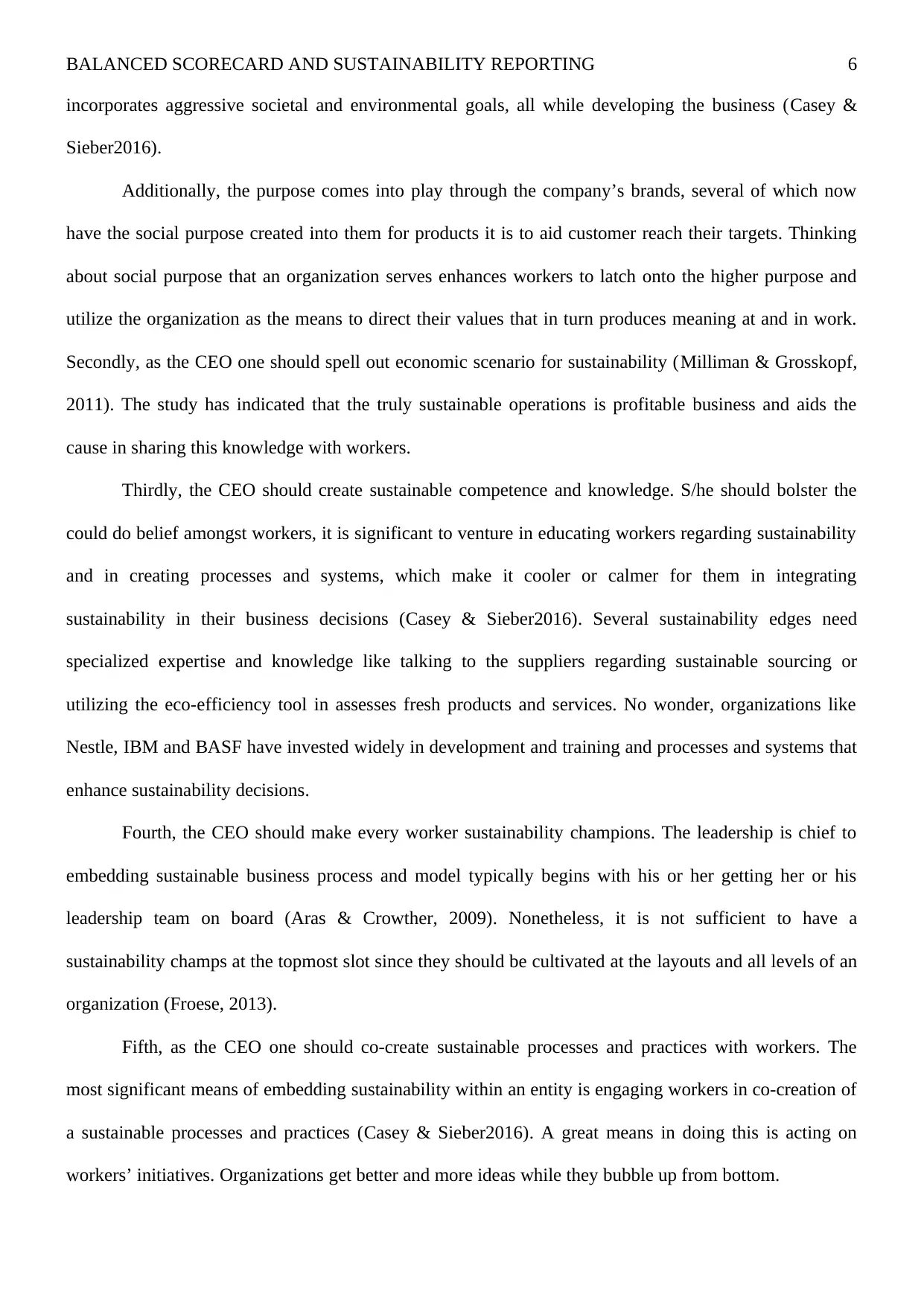
BALANCED SCORECARD AND SUSTAINABILITY REPORTING 6
incorporates aggressive societal and environmental goals, all while developing the business (Casey &
Sieber2016).
Additionally, the purpose comes into play through the company’s brands, several of which now
have the social purpose created into them for products it is to aid customer reach their targets. Thinking
about social purpose that an organization serves enhances workers to latch onto the higher purpose and
utilize the organization as the means to direct their values that in turn produces meaning at and in work.
Secondly, as the CEO one should spell out economic scenario for sustainability (Milliman & Grosskopf,
2011). The study has indicated that the truly sustainable operations is profitable business and aids the
cause in sharing this knowledge with workers.
Thirdly, the CEO should create sustainable competence and knowledge. S/he should bolster the
could do belief amongst workers, it is significant to venture in educating workers regarding sustainability
and in creating processes and systems, which make it cooler or calmer for them in integrating
sustainability in their business decisions (Casey & Sieber2016). Several sustainability edges need
specialized expertise and knowledge like talking to the suppliers regarding sustainable sourcing or
utilizing the eco-efficiency tool in assesses fresh products and services. No wonder, organizations like
Nestle, IBM and BASF have invested widely in development and training and processes and systems that
enhance sustainability decisions.
Fourth, the CEO should make every worker sustainability champions. The leadership is chief to
embedding sustainable business process and model typically begins with his or her getting her or his
leadership team on board (Aras & Crowther, 2009). Nonetheless, it is not sufficient to have a
sustainability champs at the topmost slot since they should be cultivated at the layouts and all levels of an
organization (Froese, 2013).
Fifth, as the CEO one should co-create sustainable processes and practices with workers. The
most significant means of embedding sustainability within an entity is engaging workers in co-creation of
a sustainable processes and practices (Casey & Sieber2016). A great means in doing this is acting on
workers’ initiatives. Organizations get better and more ideas while they bubble up from bottom.
incorporates aggressive societal and environmental goals, all while developing the business (Casey &
Sieber2016).
Additionally, the purpose comes into play through the company’s brands, several of which now
have the social purpose created into them for products it is to aid customer reach their targets. Thinking
about social purpose that an organization serves enhances workers to latch onto the higher purpose and
utilize the organization as the means to direct their values that in turn produces meaning at and in work.
Secondly, as the CEO one should spell out economic scenario for sustainability (Milliman & Grosskopf,
2011). The study has indicated that the truly sustainable operations is profitable business and aids the
cause in sharing this knowledge with workers.
Thirdly, the CEO should create sustainable competence and knowledge. S/he should bolster the
could do belief amongst workers, it is significant to venture in educating workers regarding sustainability
and in creating processes and systems, which make it cooler or calmer for them in integrating
sustainability in their business decisions (Casey & Sieber2016). Several sustainability edges need
specialized expertise and knowledge like talking to the suppliers regarding sustainable sourcing or
utilizing the eco-efficiency tool in assesses fresh products and services. No wonder, organizations like
Nestle, IBM and BASF have invested widely in development and training and processes and systems that
enhance sustainability decisions.
Fourth, the CEO should make every worker sustainability champions. The leadership is chief to
embedding sustainable business process and model typically begins with his or her getting her or his
leadership team on board (Aras & Crowther, 2009). Nonetheless, it is not sufficient to have a
sustainability champs at the topmost slot since they should be cultivated at the layouts and all levels of an
organization (Froese, 2013).
Fifth, as the CEO one should co-create sustainable processes and practices with workers. The
most significant means of embedding sustainability within an entity is engaging workers in co-creation of
a sustainable processes and practices (Casey & Sieber2016). A great means in doing this is acting on
workers’ initiatives. Organizations get better and more ideas while they bubble up from bottom.
⊘ This is a preview!⊘
Do you want full access?
Subscribe today to unlock all pages.

Trusted by 1+ million students worldwide
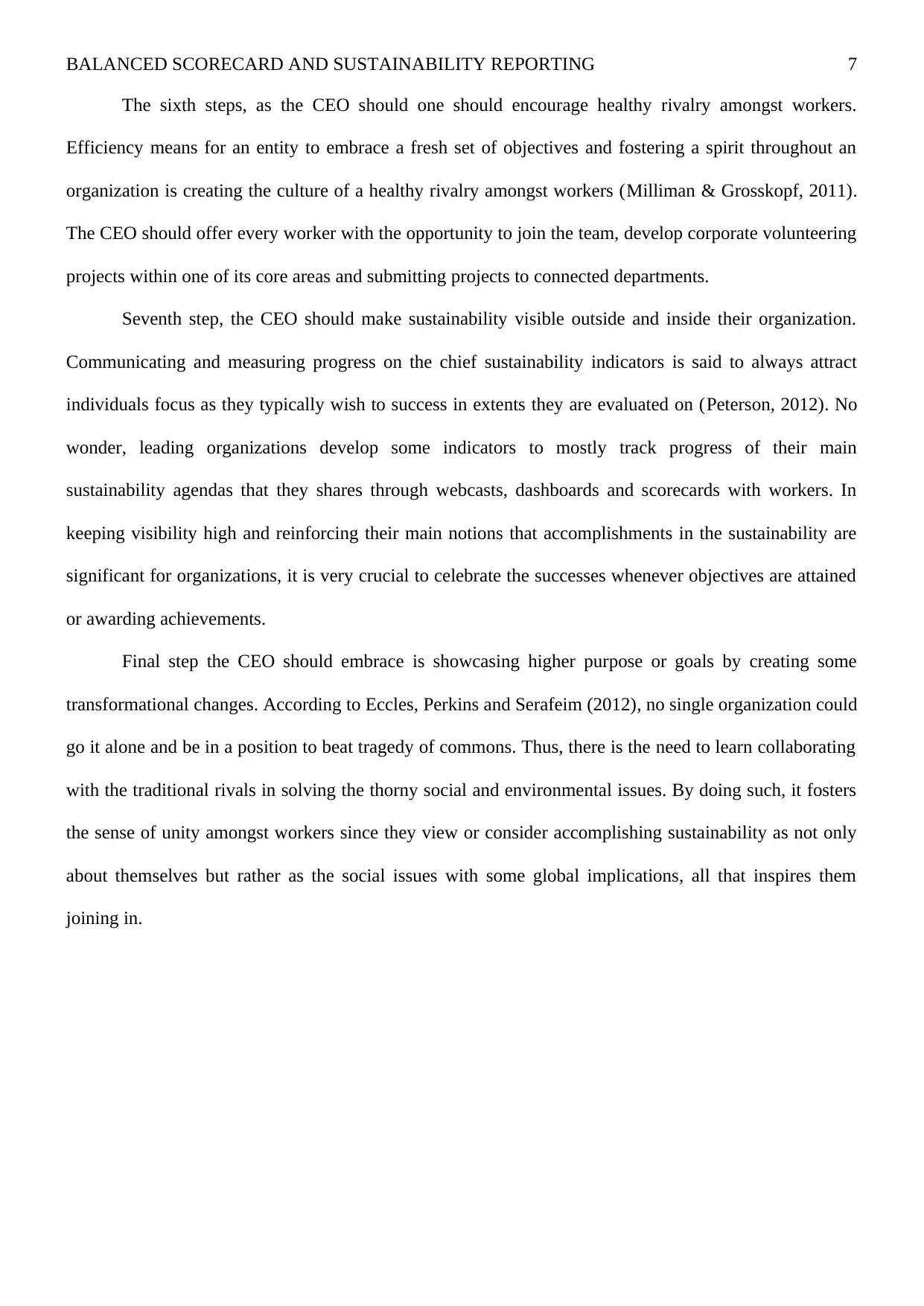
BALANCED SCORECARD AND SUSTAINABILITY REPORTING 7
The sixth steps, as the CEO should one should encourage healthy rivalry amongst workers.
Efficiency means for an entity to embrace a fresh set of objectives and fostering a spirit throughout an
organization is creating the culture of a healthy rivalry amongst workers (Milliman & Grosskopf, 2011).
The CEO should offer every worker with the opportunity to join the team, develop corporate volunteering
projects within one of its core areas and submitting projects to connected departments.
Seventh step, the CEO should make sustainability visible outside and inside their organization.
Communicating and measuring progress on the chief sustainability indicators is said to always attract
individuals focus as they typically wish to success in extents they are evaluated on (Peterson, 2012). No
wonder, leading organizations develop some indicators to mostly track progress of their main
sustainability agendas that they shares through webcasts, dashboards and scorecards with workers. In
keeping visibility high and reinforcing their main notions that accomplishments in the sustainability are
significant for organizations, it is very crucial to celebrate the successes whenever objectives are attained
or awarding achievements.
Final step the CEO should embrace is showcasing higher purpose or goals by creating some
transformational changes. According to Eccles, Perkins and Serafeim (2012), no single organization could
go it alone and be in a position to beat tragedy of commons. Thus, there is the need to learn collaborating
with the traditional rivals in solving the thorny social and environmental issues. By doing such, it fosters
the sense of unity amongst workers since they view or consider accomplishing sustainability as not only
about themselves but rather as the social issues with some global implications, all that inspires them
joining in.
The sixth steps, as the CEO should one should encourage healthy rivalry amongst workers.
Efficiency means for an entity to embrace a fresh set of objectives and fostering a spirit throughout an
organization is creating the culture of a healthy rivalry amongst workers (Milliman & Grosskopf, 2011).
The CEO should offer every worker with the opportunity to join the team, develop corporate volunteering
projects within one of its core areas and submitting projects to connected departments.
Seventh step, the CEO should make sustainability visible outside and inside their organization.
Communicating and measuring progress on the chief sustainability indicators is said to always attract
individuals focus as they typically wish to success in extents they are evaluated on (Peterson, 2012). No
wonder, leading organizations develop some indicators to mostly track progress of their main
sustainability agendas that they shares through webcasts, dashboards and scorecards with workers. In
keeping visibility high and reinforcing their main notions that accomplishments in the sustainability are
significant for organizations, it is very crucial to celebrate the successes whenever objectives are attained
or awarding achievements.
Final step the CEO should embrace is showcasing higher purpose or goals by creating some
transformational changes. According to Eccles, Perkins and Serafeim (2012), no single organization could
go it alone and be in a position to beat tragedy of commons. Thus, there is the need to learn collaborating
with the traditional rivals in solving the thorny social and environmental issues. By doing such, it fosters
the sense of unity amongst workers since they view or consider accomplishing sustainability as not only
about themselves but rather as the social issues with some global implications, all that inspires them
joining in.
Paraphrase This Document
Need a fresh take? Get an instant paraphrase of this document with our AI Paraphraser
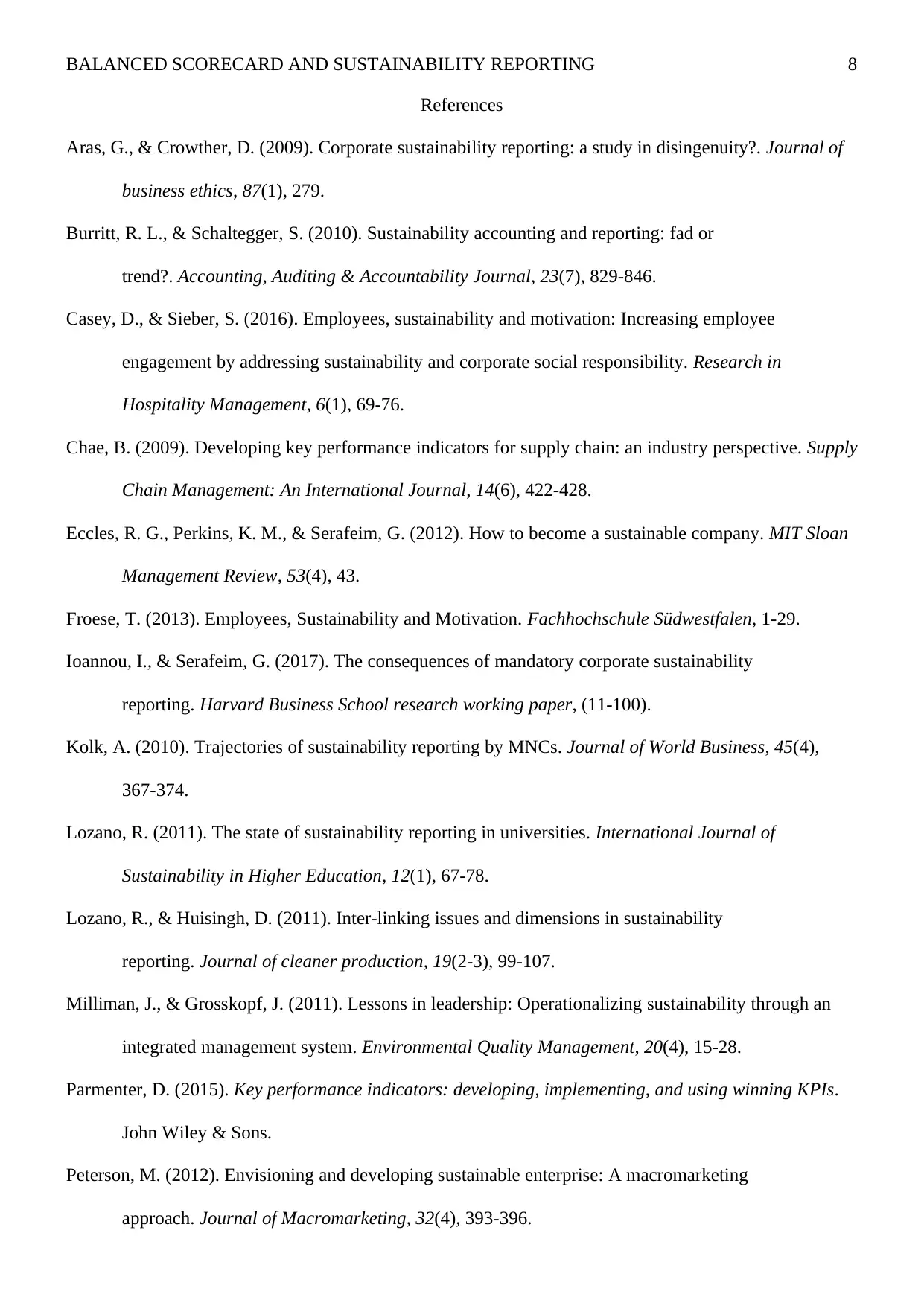
BALANCED SCORECARD AND SUSTAINABILITY REPORTING 8
References
Aras, G., & Crowther, D. (2009). Corporate sustainability reporting: a study in disingenuity?. Journal of
business ethics, 87(1), 279.
Burritt, R. L., & Schaltegger, S. (2010). Sustainability accounting and reporting: fad or
trend?. Accounting, Auditing & Accountability Journal, 23(7), 829-846.
Casey, D., & Sieber, S. (2016). Employees, sustainability and motivation: Increasing employee
engagement by addressing sustainability and corporate social responsibility. Research in
Hospitality Management, 6(1), 69-76.
Chae, B. (2009). Developing key performance indicators for supply chain: an industry perspective. Supply
Chain Management: An International Journal, 14(6), 422-428.
Eccles, R. G., Perkins, K. M., & Serafeim, G. (2012). How to become a sustainable company. MIT Sloan
Management Review, 53(4), 43.
Froese, T. (2013). Employees, Sustainability and Motivation. Fachhochschule Südwestfalen, 1-29.
Ioannou, I., & Serafeim, G. (2017). The consequences of mandatory corporate sustainability
reporting. Harvard Business School research working paper, (11-100).
Kolk, A. (2010). Trajectories of sustainability reporting by MNCs. Journal of World Business, 45(4),
367-374.
Lozano, R. (2011). The state of sustainability reporting in universities. International Journal of
Sustainability in Higher Education, 12(1), 67-78.
Lozano, R., & Huisingh, D. (2011). Inter-linking issues and dimensions in sustainability
reporting. Journal of cleaner production, 19(2-3), 99-107.
Milliman, J., & Grosskopf, J. (2011). Lessons in leadership: Operationalizing sustainability through an
integrated management system. Environmental Quality Management, 20(4), 15-28.
Parmenter, D. (2015). Key performance indicators: developing, implementing, and using winning KPIs.
John Wiley & Sons.
Peterson, M. (2012). Envisioning and developing sustainable enterprise: A macromarketing
approach. Journal of Macromarketing, 32(4), 393-396.
References
Aras, G., & Crowther, D. (2009). Corporate sustainability reporting: a study in disingenuity?. Journal of
business ethics, 87(1), 279.
Burritt, R. L., & Schaltegger, S. (2010). Sustainability accounting and reporting: fad or
trend?. Accounting, Auditing & Accountability Journal, 23(7), 829-846.
Casey, D., & Sieber, S. (2016). Employees, sustainability and motivation: Increasing employee
engagement by addressing sustainability and corporate social responsibility. Research in
Hospitality Management, 6(1), 69-76.
Chae, B. (2009). Developing key performance indicators for supply chain: an industry perspective. Supply
Chain Management: An International Journal, 14(6), 422-428.
Eccles, R. G., Perkins, K. M., & Serafeim, G. (2012). How to become a sustainable company. MIT Sloan
Management Review, 53(4), 43.
Froese, T. (2013). Employees, Sustainability and Motivation. Fachhochschule Südwestfalen, 1-29.
Ioannou, I., & Serafeim, G. (2017). The consequences of mandatory corporate sustainability
reporting. Harvard Business School research working paper, (11-100).
Kolk, A. (2010). Trajectories of sustainability reporting by MNCs. Journal of World Business, 45(4),
367-374.
Lozano, R. (2011). The state of sustainability reporting in universities. International Journal of
Sustainability in Higher Education, 12(1), 67-78.
Lozano, R., & Huisingh, D. (2011). Inter-linking issues and dimensions in sustainability
reporting. Journal of cleaner production, 19(2-3), 99-107.
Milliman, J., & Grosskopf, J. (2011). Lessons in leadership: Operationalizing sustainability through an
integrated management system. Environmental Quality Management, 20(4), 15-28.
Parmenter, D. (2015). Key performance indicators: developing, implementing, and using winning KPIs.
John Wiley & Sons.
Peterson, M. (2012). Envisioning and developing sustainable enterprise: A macromarketing
approach. Journal of Macromarketing, 32(4), 393-396.
1 out of 8
Related Documents
Your All-in-One AI-Powered Toolkit for Academic Success.
+13062052269
info@desklib.com
Available 24*7 on WhatsApp / Email
![[object Object]](/_next/static/media/star-bottom.7253800d.svg)
Unlock your academic potential
Copyright © 2020–2025 A2Z Services. All Rights Reserved. Developed and managed by ZUCOL.





